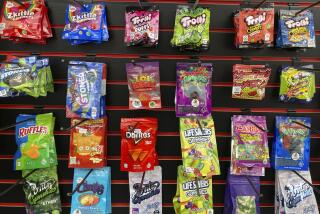Rampant Drug Abuse Among Youths Tears Heart of Nation
- Share via
You see it in poll after poll: Throughout the nation, people regard drug abuse by children and teen-agers as a major problem in American schools.
Even so, the problem is more serious than many people--even teachers and parents of young drug users--realize. That was my conclusion as I sorted through some information released recently by the U.S. Department of Education, and I must admit I underestimated the danger, too.
The facts and statistics alone are chilling.
The United States has the highest rate of teen-age drug use among industrialized nations, and children from all ethnicities, economic backgrounds and parts of the country are participating.
It’s not just a big-city phenomenon. Among high school seniors from non-metropolitan areas in 1990 (the latest year for which data is available), 30% reported illegal drug use in the previous year, barely below the big-city rate of 33%.
And let’s smash another common misperception while we’re at it. Black students are less likely to use drugs than white students.
Drug use starts at a startlingly early age for many children. More than half of the sixth- graders surveyed said they felt significant peer pressure to try cigarettes, as well as beer, wine or other alcohol products. One in three sixth-graders felt pressured to try marijuana, cocaine or crack.
And when pressured, many succumb. More than 70% of eighth-graders have tried alcohol, and about 27% of them have been drunk once or more.
*
Incidentally, kids in fourth through sixth grades said that film and television had the greatest influence (even over peer pressure) in making cigarettes and alcohol look appealing.
I’m not surprised that alcohol is the most commonly used drug among youth. My sense is that too few students and parents take it seriously as a real drug.
But by their senior year, 88% of students in the class of 1991 had used alcohol in the preceding year. And 30% of the seniors reported at least one incident of heavy drinking--five or more servings on one occasion--in the previous year.
Teen-agers consume about 35% of all wine coolers sold in the U.S., and about 1.1 billion cans and bottles of beer each year.
No wonder that alcohol-related auto accidents are the main killer of people 15 to 24. Alcohol also figures in half of youth deaths by drowning, fire, suicide and homicide.
Marijuana is a less commonly used, but equally dangerous drug: 24% of seniors in 1991 reported having used it in the past year. Incidentally, the marijuana used now is typically five to 20 times more potent than it was just 10 years ago.
Crack is also a favorite these days, partly because of its price: as low as $5. It’s more addictive than heroin, with addiction often starting after just a few uses. In some cases, crack kills instantly through cardiac arrest or respiratory failure.
Drug use by students is often reflected in their performance and behavior at school, the Department of Education studies found.
For example, students who use marijuana are twice as likely to average D’s and F’s than their peers. Twelfth-graders who use drugs heavily cut classes at three times the rate of drug-free students.
*
Those same students are also three times more likely to vandalize campus property, and twice as likely to get into fights at school or work.
If your son or daughter is using drugs, either experimentally or heavily, there are usually some pretty clear signals. In next week’s column, I’ll explain how to spot them and what you can do to prevent or intervene in your child’s drug use.
In the meantime, you can get more information from the Department of Education’s free book “Schools Without Drugs” by calling (800) 624-0100.
More to Read
Sign up for Essential California
The most important California stories and recommendations in your inbox every morning.
You may occasionally receive promotional content from the Los Angeles Times.










